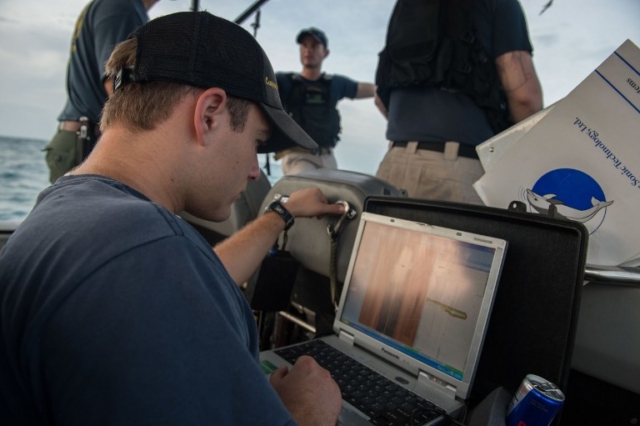Indonesia’s Search and Rescue agency said on Tuesday they have yet to confirm whether two metal objects that were detected underwater by a U.S. search team are debris from the crashed AirAsia 8501 plane.
“USS Fort Worth detected sonar (of) two metal objects, but we still need to confirm if this is part of the plane,” Fransiskus Bambang Soelistyo, chief of Indonesia’s National Search and Rescue Agency said.
Soelistyo said the U.S. ship detected the metal objects on the seabed at a depth of 28 meters (92 feet) and was attempting the identify them.
Seven large objects have now been located on the ocean floor that could be pieces of the fuselage, but strong currents, silt and mud have kept divers from seeing or reaching them.
The Singapore-bound Airbus A320-200 plunged into the Java Sea on December 28 shortly after taking off from Indonesia’s second biggest city, Surabaya, with 162 passengers on board.
Indonesian officials believe they may have located the tail and parts of the fuselage of the plane at the bottom of the sea, but strong currents, high winds and big waves have hindered attempts to send divers to investigate.
“Today the weather is good enough but the current underwater is still strong at two to four knots and so we can’t use ROV (Remotely Operated Underwater Vehicle) or search with divers,” said Soelistyo.
A multi-country search operation is underway off the coast of Borneo island looking for the more bodies and black box that carry crucial flight information.
The recorders are housed in the tail section of the Airbus, making retrieval of that part of the aircraft crucial.
The Bodies of 39 crew and passengers were retrieved. 16 of the victims have been identified and forensic experts are working around the clock to identify the others.
Indonesia’s meteorological agency has said seasonal tropical storms probably contributed to the crash.
The search operation will expand by about 185 square kilometers (70 square miles), search and rescue chief Henry Bambang Soelistyo said.
Seven large objects have now been located on the ocean floor that could be pieces of the fuselage, but strong currents, silt and mud have kept divers from seeing or reaching them.
Two divers plunged into the waters during a break in the rough weather Tuesday but were unable to do much because of strong underwater currents, Soelistyo said.
Dozens of new airlines have popped up in Indonesia in recent years to meet the industry’s booming demand, but a string of deadly accidents has raised concerns about safety.
Experts say poor maintenance, rule-bending and a shortage of trained personnel are largely to blame. Infrastructure has also failed to keep pace with exploding demand.
The country’s transportation ministry said it was cracking down after it was discovered that Flight 8501 did not have a permit to fly between Surabaya, Indonesia, and Singapore on the day of the crash. It suspended two ministry officials and five workers at Surabaya’s main airport Tuesday for allowing the flight. Others are still under investigation.
All AirAsia flights on that route also have been canceled for the time being.
It is not known what caused the Airbus A320 to crash into the Java Sea 42 minutes after takeoff, though Indonesia’s Meteorology, Climatology and Geophysics Agency says bad weather appears to have been a factor.
Just before losing contact, the pilot told air traffic control he was approaching threatening clouds, but was denied permission to climb to a higher altitude because of heavy air traffic. No distress signal was issued.
No pings have been detected from the plane’s all-important cockpit voice and flight data recorders. That’s because high waves have prevented the deployment of ships that drag ping locators. The batteries in the pingers on the black boxes are likely to go dead in about 20 more days.
“We are confident that rescuers would be able to locate them in time,” said Nurcahyo Utomo, an investigator for Indonesia’s National Committee on Transportation Safety.
The search for the remaining 125 bodies has been exhausting for family members anxiously waiting to identify and bury their loved ones.
Eight Islamic clerics flew in a helicopter over the site Tuesday and scattered rice into the sea, a local tradition, and prayed for those who perished.
Story complied with information from Reuters and The Associated Press
Former NTSB medical officer Mitch Garber discusses AirAsia recovery
CCTV America interviewed Mitch Garber, a senior manager at the engineering and scientific analysis firm Engineering Systems Consultants about the latest in the search for the AirAsia crash and what clues any wreckage can hold.

 CGTN America
CGTN America This January 5, 2015 US Navy handout photo shows Navy Diver 2nd Class Daniel Soulliard, assigned to Mobile Diving and Salvage Unit (MDSU) 1, monitoring the readings from a Tow Fish side scan sonar system on board littoral combat ship USS Fort Worth’s (LCS 3) 11-meter rigid hull inflatable boat. Fort Worth is currently on station in the Java Sea and supporting Indonesian-led efforts to locate missing AirAsia Flight QZ8501. AFP PHOTO / HANDOUT / US NAVY / MC2 ANTONIO P. TURRETTO RAMOS
This January 5, 2015 US Navy handout photo shows Navy Diver 2nd Class Daniel Soulliard, assigned to Mobile Diving and Salvage Unit (MDSU) 1, monitoring the readings from a Tow Fish side scan sonar system on board littoral combat ship USS Fort Worth’s (LCS 3) 11-meter rigid hull inflatable boat. Fort Worth is currently on station in the Java Sea and supporting Indonesian-led efforts to locate missing AirAsia Flight QZ8501. AFP PHOTO / HANDOUT / US NAVY / MC2 ANTONIO P. TURRETTO RAMOS
